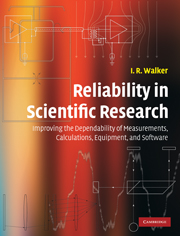 Reliability in Scientific Research
Reliability in Scientific Research Book contents
- Frontmatter
- Contents
- Preface
- List of abbreviations
- 1 Basic principles of reliability, human error, and other general issues
- 2 Mathematical calculations
- 3 Basic issues concerning hardware systems
- 4 Obtaining items from commercial sources
- 5 General points regarding the design and construction of apparatus
- 6 Vacuum-system leaks and related problems
- 7 Vacuum pumps and gauges, and other vacuum-system concerns
- 8 Mechanical devices and systems
- 9 Cryogenic systems
- 10 Visible and near-visible optics
- 11 Electronic systems
- 12 Interconnecting, wiring, and cabling for electronics
- 13 Computer hardware and software, and stored information
- 14 Experimental method
- Index
- References
9 - Cryogenic systems
Published online by Cambridge University Press: 05 June 2012
- Frontmatter
- Contents
- Preface
- List of abbreviations
- 1 Basic principles of reliability, human error, and other general issues
- 2 Mathematical calculations
- 3 Basic issues concerning hardware systems
- 4 Obtaining items from commercial sources
- 5 General points regarding the design and construction of apparatus
- 6 Vacuum-system leaks and related problems
- 7 Vacuum pumps and gauges, and other vacuum-system concerns
- 8 Mechanical devices and systems
- 9 Cryogenic systems
- 10 Visible and near-visible optics
- 11 Electronic systems
- 12 Interconnecting, wiring, and cabling for electronics
- 13 Computer hardware and software, and stored information
- 14 Experimental method
- Index
- References
Summary
Introduction
Lack of reliability in cryogenic apparatus is an especially troublesome problem. This is partly because of the inherent susceptibility of such apparatus to breakdowns. The difficulties are magnified by the inaccessibility of the low-temperature components while they are in their working environment, which makes troubleshooting difficult, and immediate repair of faults virtually impossible. Because of the long times that are often needed to cool the equipment down and warm it up again, the correction and detection of defective items can be a very tedious process. Some faults that manifest themselves at low temperatures may vanish when the apparatus is warmed to room temperature. Frequently, it is possible to identify and locate these only through the use of laborious cross-checks. The high cost of liquid cryogens, and especially liquid helium, can lead to large expenditures when low-temperature faults appear. For these reasons, particular care is needed in the design, construction, and use of cryogenic equipment to prevent failures from occurring.
Reliability problems in cryogenic apparatus are primarily the result of the following effects.
(a) Leaks can occur into evacuated spaces used to provide thermal insulation. Even if such leaks are of negligible size at room temperature, they may become very large at low temperatures, owing to the special properties of gases and liquids under such conditions.
(b) Mechanical stresses are produced in the various parts during thermal cycling. These stresses are caused by differences in thermal expansion coefficients and temperature gradients. They can cause tubes to bend, wires and solder joints to break, leaks to form, and moving parts to seize. Fatigue failure (see Section 3.11) is potentially a serious issue. […]
- Type
- Chapter
- Information
- Reliability in Scientific ResearchImproving the Dependability of Measurements, Calculations, Equipment, and Software, pp. 285 - 309Publisher: Cambridge University PressPrint publication year: 2011
